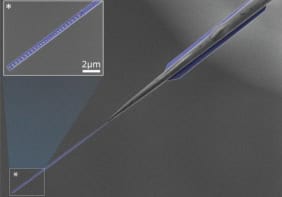What do you get when you combine a quantum cascade laser with an optical antenna? The answer, according to researchers in the US, is a compact device that produces an extremely small spot of light that could be used to image viruses or strands of DNA at much higher resolutions than possible with today’s microscopes (Appl. Phys. Lett. 91 173113).

Many structures within living cells are less than one micrometre in size and therefore biologists are keen to have a tabletop microscope that can analyse samples at resolutions of hundreds of nanometres or less. However, the spatial resolution of a conventional microscope is always larger than the wavelength of the light used — which is typically several micrometres in a modern Fourier transform infrared microscope.
Now, Federico Capasso and colleagues at Harvard University and Agilent Laboratories have worked out a way to focus infrared light from a quantum cascade laser to a spot 100 nm or less in size. Such a spot could, in principle, be scanned across a sample to generate an image with nanoscale resolution.
Quantum cascade lasers use multiple alternating layers of high- and low-band-gap semiconductors to create a series of electron “traps” or quantum wells. The energy levels of the wells are such that electrons “cascade” through the device, emitting a photon at each step. Unlike conventional semiconductor lasers, quantum cascade lasers can be tuned to a wide range of emission wavelengths, and are ideally suited to operating at the mid-infrared wavelengths favoured for biochemical applications.
The trick according to Capasso, who is co-inventor of the quantum cascade laser, is to focus the light by adding an optical antenna to the laser. Such an antenna consists of two small gold rods that lay end-to-end separated by a tiny gap. The laser light’s electric field causes the electrons in the nanorods to oscillate and accumulate at the gap ends. This creates an intense spot of light in the gap, and this light could be in principle, shone onto a sample.
The team put antennas on two quantum cascade lasers that had emission wavelengths of 7 μm and 5 μm. In each case, sharp optical spots were observed, each having dimensions comparable to the antenna gaps (100 nm and 70 nm respectively). “Typical Fourier transform interferometer microscopes have a spatial resolution of 10-20 μm. We can go two orders of magnitude below that,” said Capasso
Building a microscope from the modified quantum cascade laser will be the next step, Capasso told physicsworld.com. The localization of light in the gap is a “near-field” effect. To use the light for imaging or spectroscopy, samples would need to be brought very close to the gap.



